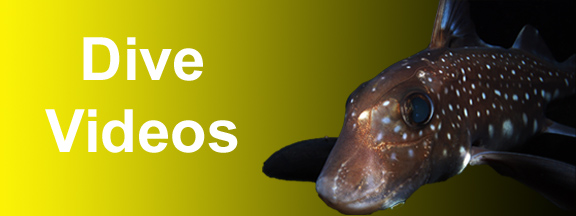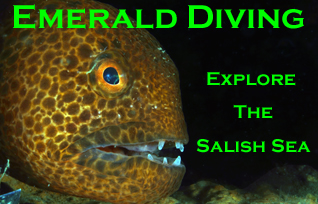

Local Sites
Local Sites
Disclaimer
All of the information in this guide is based upon my personal experiences and observations. Your experiences will be somewhat different as everyone perceives things differently. Conditions at any site are subject to change at a moment’s notice. Current, visibility, hazards, and even the local marine life are all affected by a multitude of interactive variables. Although this guide is intended to help you better understand some of the variables affecting each of these sites, no guide is capable of providing all information necessary to dive any site in complete safety.
Just because I dive these sites doesn't mean you should. Only you can assess your capabilities and limits. Dive safe, dive within your limits, take responsibility for your own actions, and enjoy, cherish, and preserve this emerald jewel that Mother Nature has bestowed to us.
How to Use This Guide
Dive site reviews are sorted within each of three “regions” - Puget Sound & Hood Canal (combined), the San Juan Islands, and the Western Strait of Juan de Fuca. Click on an area below to see the dive site map for the selected region.
All of the information in this guide is based upon my personal experiences and observations. Your experiences will be somewhat different as everyone perceives things differently. Conditions at any site are subject to change at a moment’s notice. Current, visibility, hazards, and even the local marine life are all affected by a multitude of interactive variables. Although this guide is intended to help you better understand some of the variables affecting each of these sites, no guide is capable of providing all information necessary to dive any site in complete safety.
Just because I dive these sites doesn't mean you should. Only you can assess your capabilities and limits. Dive safe, dive within your limits, take responsibility for your own actions, and enjoy, cherish, and preserve this emerald jewel that Mother Nature has bestowed to us.
How to Use This Guide
Dive site reviews are sorted within each of three “regions” - Puget Sound & Hood Canal (combined), the San Juan Islands, and the Western Strait of Juan de Fuca. Click on an area below to see the dive site map for the selected region.
Each dive site review includes the following sections:
Topography: A brief description of the underwater geologic features associated with the dive site - typically a wall, natural reef, or man-made reef.
Area marine life rating: Subjective rating of the variety, quantity, diversity, and uniqueness of the marine life I typically find at the site. Sites are rated on a scale of 1 (poor) to 5 (exceptional). I only rate sites relative to others in the same region.
Area structure rating: Subjective rating of the site’s underwater structure. Sites are rated on a scale of 1 (poor) to 5 (exceptional). I have a bias towards natural reefs and walls. Again, sites are only rated against others in the same region.
Diving depth: The maximum depth I typically achieve when I dive the site. This does not mean you should dive to this depth or that the depth listed is the deepest you can go at the site. I list this depth to indicate where I think the “sweet spot” is for each site. You must decide whether these depths are within your training, limits, and comfort level.
Highlight: A brief statement regarding why the site is listed as a favorite.
Skill level: General indicator of the minimal level of diver I feel comfortable taking to the site. I assume every diver has completed certification from an authorized recreational scuba agency and is current on skills. My progressive skill level guidelines are as follows:
Novice: Good basic diving skills - air management, dive planning, buddy contact, safety, underwater navigation, depth management, and buoyancy control. Proficient and comfortable diving on flat and moderately sloping substrates to depths of 80 feet.
Intermediate: Proficient and comfortable dealing with “no floor” situations (i.e. wall dives), handling light to moderate current and swell, performing free ascents from 50 feet, and diving to depths of 100 feet.
Advanced: Highly developed and refined diving skills. Ability to quickly and accurately assess situations above and below the water and adjust dive plans accordingly. Proficient in handling moderate to heavy current and swell, performing free ascents from 90 feet, and diving to depths of up to 130 feet.
GPS coordinates: Most GPS coordinates were taken from a boat anchored next to the dive site. All GPS coordinates are list in DD MM.MMM format.
Access by boat: Location of the dive site using nautical reference points.
Access by shore: Directions on how to get to the site by land if a public shore access is available. Many of the sites listed in this book are only accessible by boat.
Dive profile: Details regarding how I dive the site and what I expect to encounter during the dive.
Preferred gas mix: The Nitrox mix I prefer when diving the site. Nitrox has evolved into a recreational scuba gas that enhances safety and/or increases no-decompression (no-deco) time, especially when doing multiple dives in a day. My mix preference is based upon not exceeding 1.4 ATA PPO2 at my maximum operating depth. Simply ignore this section if you are not a Nitrox certified diver.
Current observations: How I time the current when planning a dive at the site. These observations are provided solely as a guideline. Do not rely exclusively on any current prediction before deciding whether to enter the water. Keen observations of current before and during the dive are critical to diving safely.
Boat launch: Name of the boat launch or launches I use when diving the site. I usually launch my trailerable boat at the public ramp closest to the dive site. Note that I live in the Seattle area, so I predominately use boat launches on the east side of Puget Sound.
Facilities: A list of facilities available at this dive site.
Hazards: A list of potential hazards I have noted at the dive site. Other hazards may exist. Again, keen observation before and during the dive are critical to safely diving any site.
Marine life: A brief description of some of the more common and/or noteworthy marine species I find at the site.
Area marine life rating: Subjective rating of the variety, quantity, diversity, and uniqueness of the marine life I typically find at the site. Sites are rated on a scale of 1 (poor) to 5 (exceptional). I only rate sites relative to others in the same region.
Area structure rating: Subjective rating of the site’s underwater structure. Sites are rated on a scale of 1 (poor) to 5 (exceptional). I have a bias towards natural reefs and walls. Again, sites are only rated against others in the same region.
Diving depth: The maximum depth I typically achieve when I dive the site. This does not mean you should dive to this depth or that the depth listed is the deepest you can go at the site. I list this depth to indicate where I think the “sweet spot” is for each site. You must decide whether these depths are within your training, limits, and comfort level.
Highlight: A brief statement regarding why the site is listed as a favorite.
Skill level: General indicator of the minimal level of diver I feel comfortable taking to the site. I assume every diver has completed certification from an authorized recreational scuba agency and is current on skills. My progressive skill level guidelines are as follows:
Novice: Good basic diving skills - air management, dive planning, buddy contact, safety, underwater navigation, depth management, and buoyancy control. Proficient and comfortable diving on flat and moderately sloping substrates to depths of 80 feet.
Intermediate: Proficient and comfortable dealing with “no floor” situations (i.e. wall dives), handling light to moderate current and swell, performing free ascents from 50 feet, and diving to depths of 100 feet.
Advanced: Highly developed and refined diving skills. Ability to quickly and accurately assess situations above and below the water and adjust dive plans accordingly. Proficient in handling moderate to heavy current and swell, performing free ascents from 90 feet, and diving to depths of up to 130 feet.
GPS coordinates: Most GPS coordinates were taken from a boat anchored next to the dive site. All GPS coordinates are list in DD MM.MMM format.
Access by boat: Location of the dive site using nautical reference points.
Access by shore: Directions on how to get to the site by land if a public shore access is available. Many of the sites listed in this book are only accessible by boat.
Dive profile: Details regarding how I dive the site and what I expect to encounter during the dive.
Preferred gas mix: The Nitrox mix I prefer when diving the site. Nitrox has evolved into a recreational scuba gas that enhances safety and/or increases no-decompression (no-deco) time, especially when doing multiple dives in a day. My mix preference is based upon not exceeding 1.4 ATA PPO2 at my maximum operating depth. Simply ignore this section if you are not a Nitrox certified diver.
Current observations: How I time the current when planning a dive at the site. These observations are provided solely as a guideline. Do not rely exclusively on any current prediction before deciding whether to enter the water. Keen observations of current before and during the dive are critical to diving safely.
Boat launch: Name of the boat launch or launches I use when diving the site. I usually launch my trailerable boat at the public ramp closest to the dive site. Note that I live in the Seattle area, so I predominately use boat launches on the east side of Puget Sound.
Facilities: A list of facilities available at this dive site.
Hazards: A list of potential hazards I have noted at the dive site. Other hazards may exist. Again, keen observation before and during the dive are critical to safely diving any site.
Marine life: A brief description of some of the more common and/or noteworthy marine species I find at the site.
Depth and distance
Most depths and distances referenced in this guide are approximate values based upon my best judgment. Water depths vary by up to about 14 feet in Washington waters due to tides. When referencing depths, I try to list the “average” depth between high and low tide, or give a range. A good rule of thumb is that depth can vary by up to 10 feet from the number listed.
Most depths and distances referenced in this guide are approximate values based upon my best judgment. Water depths vary by up to about 14 feet in Washington waters due to tides. When referencing depths, I try to list the “average” depth between high and low tide, or give a range. A good rule of thumb is that depth can vary by up to 10 feet from the number listed.

Click on an area to view dive sites and reviews
Emerald Diving
Explore the coastal and inland waters of
Washington and BC
Explore the coastal and inland waters of
Washington and BC














